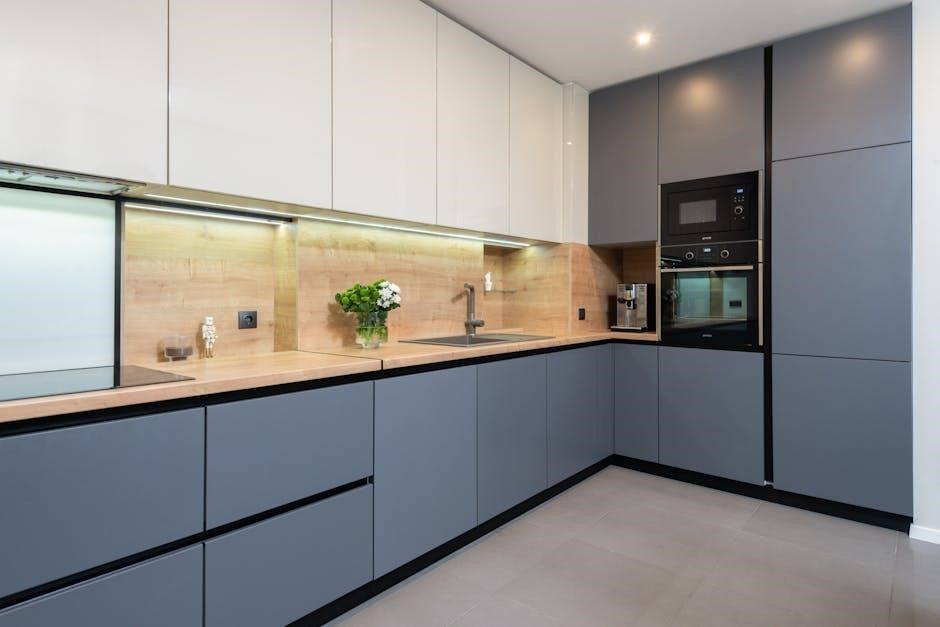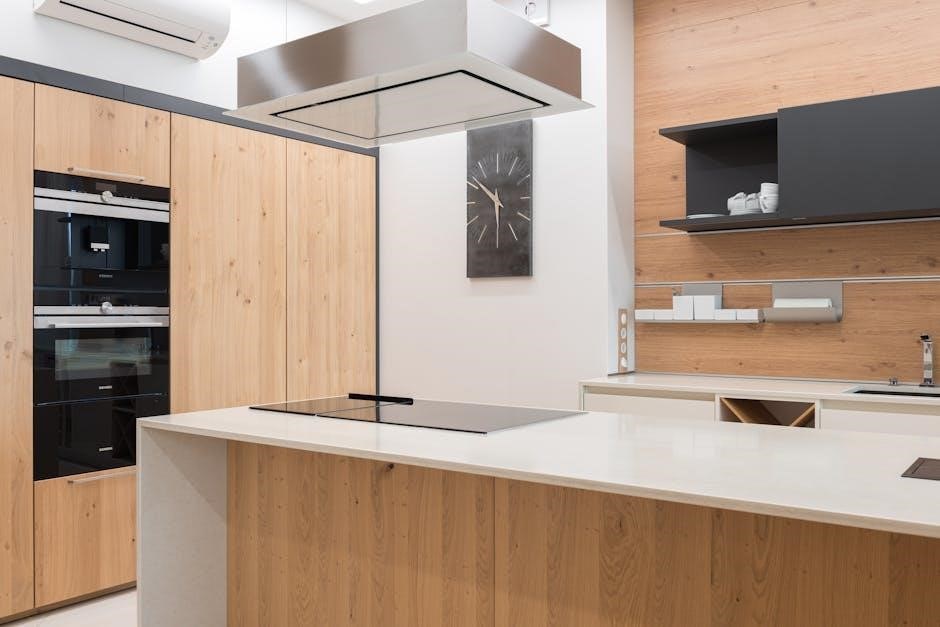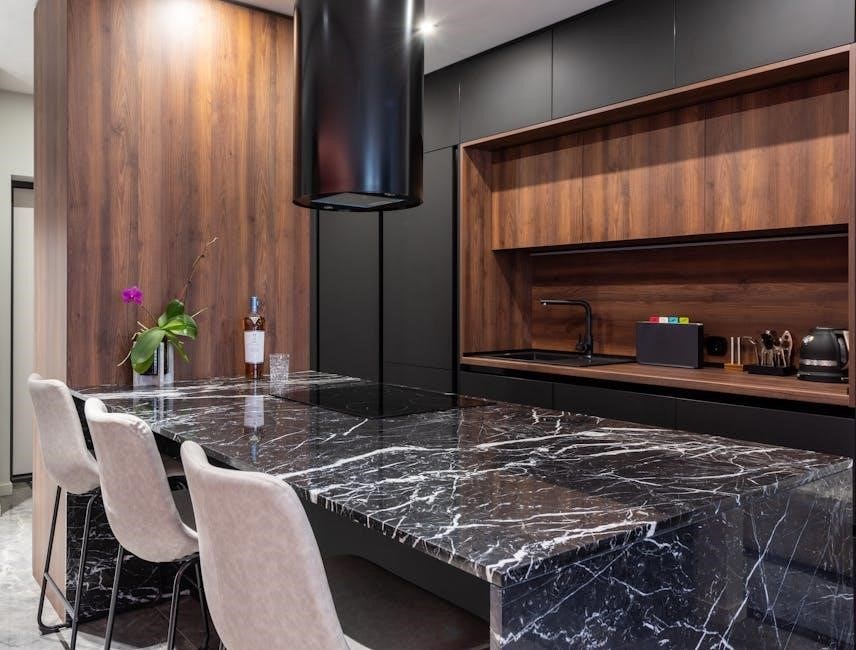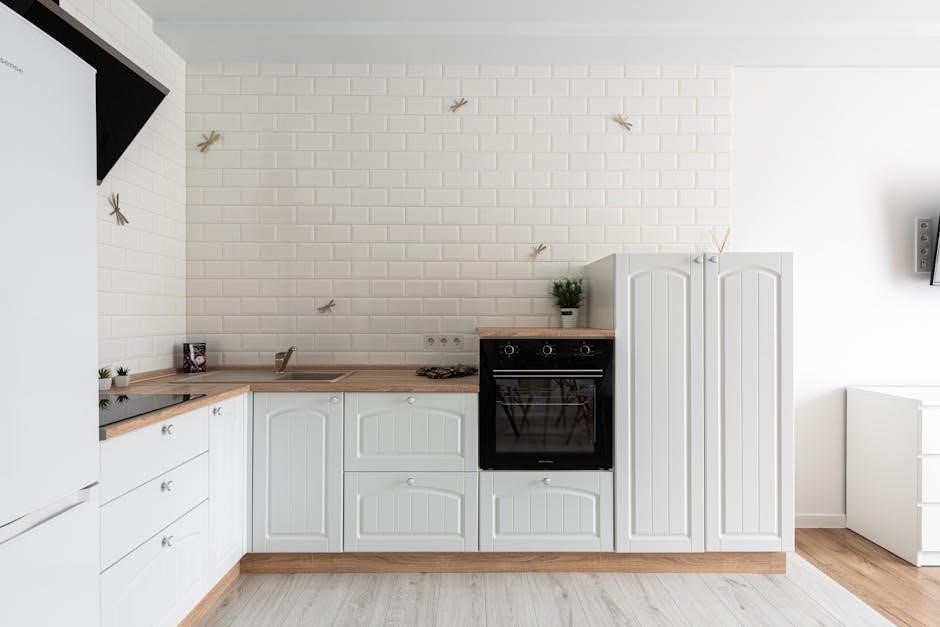Welcome to the Bosch Induction Hob manual. This guide provides essential instructions for safe and efficient operation. Discover features, cooking techniques, and maintenance tips for optimal performance.
1.1 Overview of Bosch Induction Hob
The Bosch Induction Hob is a modern cooking solution that uses electromagnetic fields to heat compatible cookware directly. It features touch controls, multiple cooking zones, and advanced sensors for automatic heat adjustment. Designed for energy efficiency, it ensures faster heating and precise temperature control. The hob also includes safety features like residual heat indicators and child safety locks. With a sleek, durable design, it offers a user-friendly interface and smart connectivity options, making it ideal for contemporary kitchens; Its adaptability to various cooking styles and eco-friendly performance make it a popular choice for home cooks and professionals alike.
1.2 Importance of Following Instructions
Adhering to the instructions ensures safe and efficient use of the Bosch Induction Hob; Proper operation prevents accidents, prolongs appliance lifespan, and optimizes energy efficiency. Misuse can lead to malfunctions or damage. Following guidelines helps users navigate features like timers, sensors, and safety locks effectively. It also ensures compliance with safety standards, protecting both the user and the appliance. Regular maintenance and correct cookware selection, as per instructions, are crucial for trouble-free cooking experiences. Always refer to the manual for troubleshooting and maintenance tips to keep your hob in prime condition and maintain warranty validity.

Safety Precautions
Ensure safe operation by following guidelines to prevent accidents and appliance damage. Always handle electrical components with care and avoid placing metal objects on the hob surface.
2.1 General Safety Guidelines
Always read the manual carefully before using your Bosch induction hob. Ensure children are kept away from the hob and supervised when nearby. Only use cookware compatible with induction cooking and check compatibility by placing a magnet on the base. Avoid placing metal objects near the hob to prevent sparks or damage. Never leave empty cookware unattended or allow it to overheat. Keep the hob surface clean and avoid spilling liquids on the controls. Allow cookware to cool before cleaning to prevent burns. Follow these guidelines to ensure safe and efficient operation.
2.2 Understanding Residual Heat Indicators
Residual heat indicators are essential for safe operation. These indicators, usually marked with an “H” or similar symbol, illuminate when cooking zones are still hot after being turned off. They ensure you avoid burns by signaling that surfaces remain hazardous. Never touch or clean the hob until the indicators have turned off, confirming the zones have cooled. This feature is a crucial safety measure to prevent accidents and ensure the longevity of your Bosch induction hob.
2.3 Safe Handling of Electrical Components
Always handle electrical components with care to avoid damage or risk of injury. Ensure the hob is switched off before cleaning or maintaining it. Avoid exposing electrical parts to water or moisture, as this can cause malfunctions or safety hazards. Never touch electrical components with wet hands or while standing on a damp surface. Keep children away from buttons and controls. For repairs, only use original Bosch parts and consult a licensed technician. Regularly inspect cords and plugs for damage. Disconnect power before servicing to ensure safety. Follow the user manual for specific guidelines on electrical care.

Components and Features
The Bosch Induction Hob features a sleek glass ceramic surface with touch controls, multiple cooking zones, and advanced sensors for precise heat control. It includes a timer, booster function, and energy-efficient technology for enhanced performance and safety.
3.1 Key Components of the Induction Hob
The Bosch Induction Hob features a glass ceramic surface for durability and easy cleaning, touch-sensitive controls for intuitive operation, and cooking zones that adapt to pan sizes. It includes residual heat indicators for safety, a control panel with symbols for functions like the timer, and sensors for automatic heat adjustment. These components ensure efficient, safe, and user-friendly cooking experiences, making the hob a versatile addition to modern kitchens.
3.2 Types of Cooking Zones
The Bosch Induction Hob features standard cooking zones, each designed for specific pot sizes, and booster zones for rapid heating. Some models include dual zones, combining two areas for larger cookware. These zones are clearly marked and adapt to pan sizes for efficient energy use. The hob also includes residual heat indicators for safety. The variety of zones ensures flexibility, catering to different cooking needs and enhancing overall efficiency in the kitchen.
3.3 Sensors and Automatic Functions
Bosch Induction Hobs are equipped with advanced sensors that automatically detect pan size and adjust energy use. They feature a timer function and automatic shut-off for unattended cookware. The hob also includes a booster function for faster heating and a child safety lock. These sensors ensure efficient cooking by adapting to your needs, while automatic functions enhance safety and convenience. They optimize energy consumption and provide a seamless cooking experience, making the Bosch Induction Hob both user-friendly and energy-efficient.

Installation Requirements
Ensure proper installation by placing the hob in a well-ventilated area, following electrical installation guidelines, and maintaining surrounding environment safety to meet Bosch specifications for optimal performance.
4.1 Location and Surrounding Environment
Install the Bosch induction hob in a well-ventilated area to prevent moisture buildup. Ensure the hob is placed on a heat-resistant surface, maintaining a minimum distance of 15 cm from any combustible materials. Avoid exposed locations to protect against direct sunlight or water splashes. The surrounding area should be clear of flammable items and provide easy access for maintenance. Proper positioning ensures efficient cooling and prevents damage from heat exposure, adhering to safety guidelines for optimal performance.
4.2 Electrical Installation Guidelines
Ensure the electrical supply matches the hob’s specifications, typically requiring a 220-240V, 50Hz connection. Install a dedicated 32A circuit breaker and use high-quality cables to avoid overheating. The hob must be grounded properly for safety. Avoid overloading the circuit with additional appliances. Professional installation is recommended to comply with safety standards and warranty terms. Always refer to the user manual for specific voltage and current requirements to ensure a safe and efficient electrical connection. This prevents risks of electrical hazards and guarantees proper functionality.
4.3 Ventilation Requirements
Proper ventilation is essential for efficient operation and safety. Install a suitable extractor hood or ventilation system to remove cooking fumes and moisture. Ensure the system is appropriate for your kitchen size and usage frequency. Maintain a minimum distance of 50cm between the hob and any combustible materials. Ensure the ventilation system is always functioning when the hob is in use to prevent heat buildup and maintain air quality. Regularly clean filters to ensure optimal airflow and prevent grease accumulation.

Operating the Hob
Learn to operate your Bosch induction hob safely and efficiently. Use the control panel to adjust heat settings, select cooking zones, and set timers for precise cooking control.
5.1 Turning the Hob On and Off
To turn the Bosch induction hob on, press the ON/OFF button located on the control panel. You will hear a beep, and the display will show dashes (-) to indicate it is active. To turn it off, press the same button again. The hob will emit another beep, and the display will go dark. Note that the hob may automatically switch off if a pan is removed or if no cookware is detected. Always ensure the hob is turned off when not in use for safety and energy efficiency.
5.2 Navigating the Control Panel
The Bosch induction hob features an intuitive control panel with touch-sensitive buttons and sensors. To navigate, press the ON/OFF button to activate the hob. Use the ‘+’ and ‘-‘ symbols to adjust heat settings or timer functions. The control panel also includes a timer icon and a ‘0’ symbol for accessing basic settings. Press and hold the ‘0’ symbol within 10 seconds of turning on the hob to enter settings mode. The display will guide you through options, allowing you to customize your cooking experience. Refer to your model-specific manual for detailed instructions.
5.3 Selecting and Adjusting Cooking Zones
Selecting the right cooking zone is essential for efficient cooking. Ensure the cookware size matches the zone for optimal energy use. Activate a zone by placing an induction-compatible pan on it. Use the touch controls to adjust heat levels, with options ranging from simmer to high heat. The hob automatically detects the pan’s size and adjusts energy distribution. For precise control, use the ‘+’ and ‘-‘ symbols to fine-tune settings. Always center the cookware on the zone to ensure even heating and safety.
5.4 Using the Timer Function
To use the timer, press the clock icon on the control panel. Select the desired cooking zone and set the timer by pressing the ‘+’ or ‘-‘ symbols to adjust minutes. Confirm by pressing ‘Start.’ The timer will count down, and a beep will sound when it reaches zero. The hob will automatically switch off the selected zone. To cancel, press and hold the timer button until it resets to zero. This feature ensures precise cooking control and prevents overheating, enhancing safety and convenience during meal preparation.
5.5 Adjusting Heat Settings
To adjust the heat settings, select the desired cooking zone using the control panel. Use the ‘+’ or ‘-‘ symbols to increase or decrease the heat level. The LED display will show the current heat setting. Press and hold the symbols for rapid adjustments. The hob will emit a beep to confirm changes. Ensure the cookware is compatible and properly positioned for optimal performance. Adjustments can be made at any time during cooking to achieve the perfect temperature control for your recipe, ensuring efficient and safe cooking with your Bosch induction hob.
Choosing the Right Cookware
Selecting the right cookware is crucial for optimal performance. Use cookware compatible with induction cooking, such as cast iron or stainless steel. Avoid glass or aluminum. Ensure the cookware has a flat base and a diameter matching the cooking zone. Proper cookware ensures efficient heat distribution and prevents damage to the hob. Refer to the compatibility section for more details.
6.1 Suitable Materials for Induction Cooking
For optimal performance, use cookware made from ferromagnetic materials like cast iron, stainless steel, or carbon steel. These materials interact with the magnetic field, enabling efficient heat transfer. Avoid aluminum, glass, or copper unless they have a ferromagnetic base. Ensure the cookware has a flat, even surface to maximize contact with the hob. Proper material selection ensures energy efficiency, faster heating, and prevents damage to the appliance. Always check compatibility before use.
6.2 Testing Cookware Compatibility
To ensure compatibility, place a magnet on the cookware’s base. If it sticks firmly, the material is suitable for induction cooking; Alternatively, test by placing the pan on the hob and turning it on briefly. If the hob activates and you hear a distinct noise, the cookware is compatible. Avoid using incompatible materials like pure aluminum or glass, as they won’t heat efficiently and may damage the hob. Always verify compatibility before cooking to ensure safety and optimal performance.
Cooking Tips and Techniques
Optimize your cooking with energy-efficient practices and precise heat control. Master techniques like quick stir-frying and perfect simmering to enhance your culinary experience.
7.1 Energy-Efficient Cooking Practices
Maximize energy efficiency with your Bosch induction hob by using suitable cookware and adjusting heat settings. Always choose cookware with a diameter matching the cooking zone to minimize energy loss. Utilize the residual heat indicator to continue cooking after turning off the hob, reducing overall energy consumption. Avoid overheating by selecting the right power level for your dishes. Regularly clean the hob to ensure optimal performance and energy efficiency. These practices not only save energy but also prolong the lifespan of your appliance.
7.2 Mastering Induction Cooking Methods
Induction cooking offers precise temperature control, enabling versatile techniques. Start by preheating the hob before adding cookware. For frying, use medium-high heat and adjust as needed. Simmering requires lower settings to maintain consistent heat. Experiment with booster functions for rapid heating. Ensure cookware is centered and compatible with induction to optimize performance. Regularly clean the hob to maintain efficiency. By mastering these methods, you can achieve professional-grade results while enjoying the convenience of induction technology. Practice makes perfect in exploring the full potential of your Bosch induction hob.
Cleaning and Maintenance
Regularly clean the hob with a damp cloth and mild detergent. Avoid abrasive cleaners or rough scrubbers to prevent scratching. Dry thoroughly after cleaning to maintain appearance and functionality.
8.1 Routine Cleaning Guidelines
For routine cleaning, wipe the hob with a soft, damp cloth after each use to remove spills and splatters. Use a mild detergent if needed, but avoid abrasive cleaners or scourers, as they may scratch the surface. Dry the hob thoroughly with a clean cloth to prevent water spots. For tougher stains, apply a ceramic hob cleaner and follow the product instructions. Regular cleaning ensures optimal performance and maintains the hob’s appearance. Always turn off the hob and allow it to cool before cleaning. Avoid using metal utensils or abrasive materials that could damage the surface. Keeping the hob clean also prevents residue buildup, which can interfere with heat distribution. By following these guidelines, you can keep your Bosch induction hob in excellent condition and ensure safe, efficient cooking. Additionally, cleaning the vent or fans regularly helps maintain proper ventilation and prevents dust accumulation. Remember to unplug the hob before performing any deep cleaning to avoid electrical hazards. Proper maintenance extends the lifespan of your appliance and guarantees consistent cooking results. Regular inspection of the hob’s surface for any signs of wear or damage is also recommended for early detection and repair. Adhering to these cleaning practices ensures your Bosch induction hob remains a reliable and efficient cooking companion for years to come. Cleaning is not just about aesthetics; it’s about functionality and safety. Stay consistent with your cleaning routine to enjoy hassle-free cooking experiences. Always refer to the user manual for specific cleaning recommendations tailored to your model. In case of stubborn stains, avoid using harsh chemicals, as they may damage the glass surface. Instead, let the cleaning solution sit for a few minutes before wiping it away. This method is gentle yet effective for maintaining the hob’s pristine condition. Remember, a clean hob is not only more efficient but also safer to use, reducing the risk of accidental fires or malfunctions. By dedicating a few minutes daily to cleaning, you can ensure your Bosch induction hob continues to perform at its best. Regular cleaning also helps in preventing the growth of bacteria and germs, ensuring a hygienic cooking environment. It’s a small effort that makes a big difference in both the longevity and functionality of your appliance. So, make cleaning a priority and enjoy a seamless cooking experience with your Bosch induction hob.
8.2 Caring for the Ceramic Surface
To maintain the ceramic surface of your Bosch induction hob, avoid using metal utensils, abrasive cleaners, or harsh chemicals, as they can scratch or damage the surface. Always clean spills immediately, especially acidic or sugary substances, to prevent hardening. For stubborn stains, use a gentle ceramic hob cleaner and a soft cloth. Avoid extreme temperature changes, such as placing a hot pan on a cold surface, to prevent cracking. Regularly polishing the surface with a ceramic-specific product can restore its shine. For tougher marks, apply the cleaner, let it sit, and wipe clean. Never use scourers or bleach, as they can dull the finish. Proper care ensures the ceramic surface remains durable and maintains its sleek appearance. Always refer to the user manual for recommended cleaning products. By following these tips, you can protect your hob’s surface and ensure long-lasting performance. Regular maintenance also helps prevent stains from becoming permanent. Keep the surface clean and dry to maintain its resistance to heat and spills. Avoid using rough sponges or brushes, as they can leave scratches. Instead, opt for microfiber cloths for gentle yet effective cleaning. This care routine will keep your Bosch induction hob looking like new for years. Properly caring for the ceramic surface is essential for both aesthetics and functionality. Remember, a well-maintained hob not only looks better but also cooks more efficiently. Take the time to clean and protect the surface regularly to enjoy optimal performance. Your Bosch induction hob deserves the best care to deliver exceptional results every time you cook.

Troubleshooting Common Issues
Refer to the error codes in your manual for diagnosing issues. Resetting the hob by unplugging it can resolve many malfunctions. Ensure cookware is induction-compatible and properly positioned.
9.1 Diagnosing Error Codes
Refer to your Bosch induction hob manual for specific error code meanings. Codes like E1 or E2 often indicate issues with heating or sensor malfunction. Check the display for flashing symbols or numbers. Resetting the hob by unplugging it may resolve some errors. If problems persist, contact Bosch customer support or a certified technician. For models like PUE611BB1E, ensure the cookware is compatible and properly positioned. Regular maintenance and cleaning can prevent recurring issues. Always follow the troubleshooting guide in your manual for accurate diagnostics.
9.2 Resolving Malfunctioning Zones
If a cooking zone is not functioning, ensure the cookware is compatible and properly placed. Check for blockages or debris on the hob surface. Reset the hob by unplugging it for 30 seconds. If the issue persists, refer to the error code in your manual for specific guidance. For models like PUE611BB1E, ensure the zone is not blocked by oversized cookware. Clean the hob regularly to prevent sensor malfunctions. Contact Bosch support if the problem remains unresolved after these steps.

Advanced Features
Discover advanced features like the Booster Function for rapid heating, Child Safety Lock for added protection, and Smart Connectivity for seamless app control, enhancing convenience and efficiency.
10.1 Booster Function for Faster Heating
The Booster Function on your Bosch induction hob accelerates heating, reducing cooking time. Activate it for intense heat when searing meat or boiling water quickly. Simply touch and hold the cooking zone or specific booster icon on the control panel for a few seconds. The hob will emit a tone, indicating the booster mode is active. This feature ensures rapid heat distribution, perfect for high-heat tasks. Always ensure cookware is compatible and suitable for this function to achieve optimal results.
10.2 Activating the Child Safety Lock
Enhance safety with the Child Safety Lock on your Bosch induction hob. To activate, press and hold the lock icon on the control panel for 3 seconds until it illuminates. This feature prevents accidental operation, ensuring the hob cannot be turned on by children. To deactivate, repeat the process. The lock ensures peace of mind, especially in households with young children. Always activate this feature when the hob is not in use to maintain a secure kitchen environment.
10.3 Smart Connectivity Options
Experience enhanced control with Bosch’s smart connectivity features. Compatible models allow integration with the MyBosch app, enabling remote monitoring and control of your induction hob. This feature lets you preset timer functions, monitor cooking status, and receive notifications. Ensure your hob is connected to your home Wi-Fi and follow the app’s pairing instructions. Smart connectivity offers convenience, allowing you to manage your cooking seamlessly from your smartphone, optimizing your culinary experience with ease and precision.

Energy Efficiency
Bosch induction hobs are designed to minimize energy consumption. They heat cookware directly, reducing heat loss. Follow eco-friendly practices, like matching pan sizes to zones, to optimize efficiency and lower energy use.
11.1 How Induction Hobs Save Energy
Bosch induction hobs save energy by directly heating cookware, minimizing heat loss. Unlike traditional stoves, they transfer up to 90% of energy to the pan, reducing wasted heat. This direct transfer ensures faster cooking times and lower electricity consumption. Additionally, the hob automatically adjusts power based on pan size and material, further optimizing efficiency. By using compatible cookware and following eco-friendly practices, users can maximize energy savings while maintaining high performance.
11.2 Eco-Friendly Cooking Practices
Adopting eco-friendly practices with your Bosch induction hob enhances energy efficiency. Always use cookware that matches the size of the cooking zone to minimize energy waste. Turn off the hob shortly before finishing cooking to utilize residual heat. Regularly clean and maintain the hob to ensure optimal performance. By following these practices, you reduce energy consumption and contribute to a more sustainable kitchen environment while benefiting from faster and efficient cooking.

Warranty and Support
Bosch induction hobs come with a manufacturer’s warranty. Register your appliance on MyBosch for extended benefits. Contact Bosch customer service for warranty claims and assistance.
12.1 Understanding Your Warranty
Your Bosch induction hob is backed by a manufacturer’s warranty. The standard warranty period is two years from the date of purchase. To ensure coverage, register your appliance on the MyBosch platform. The warranty covers manufacturing defects and faulty materials. However, it does not apply to damage caused by improper installation or misuse. For warranty claims, contact Bosch customer service or refer to the provided contact information in your user manual. Proper installation by a licensed professional is required to maintain warranty validity.

User Manual Guidance
This manual provides detailed instructions for installing, operating, and maintaining your Bosch induction hob. Read it carefully to ensure safe and efficient use of your appliance.
13.1 Navigating the User Manual
The user manual is organized into clear sections for easy navigation. Start with safety precautions, installation guidelines, and operating instructions. Troubleshooting and maintenance tips are also included. Use the table of contents to quickly locate specific topics. Detailed diagrams and step-by-step guides ensure clarity. Refer to the warranty section for coverage details. By following the manual, you can optimize your Bosch induction hob’s performance and lifespan. Always keep the manual handy for reference during use and maintenance.
By following this guide, you can safely and efficiently use your Bosch induction hob. Proper maintenance and adherence to instructions ensure optimal performance and longevity of the appliance.
14.1 Summary of Key Instructions
To ensure safe and efficient use of your Bosch induction hob, always read the manual, use compatible cookware, and follow installation guidelines. Regular cleaning maintains performance, while energy-efficient practices conserve power. Troubleshooting common issues and adhering to safety precautions prevent accidents. Utilize advanced features like booster functions and child locks for enhanced control. Register your appliance for warranty benefits and refer to the user manual for detailed guidance.
14.2 Final Tips for Safe and Efficient Use
Always keep the hob clean to prevent damage and ensure optimal performance. Use compatible cookware to maximize efficiency and safety. Be mindful of residual heat indicators and avoid placing metal objects on the surface. Follow energy-saving practices, such as matching pan size to cooking zones. Regularly check and maintain electrical connections. For warranty benefits, register your appliance and refer to the manual for guidance. By adhering to these tips, you ensure a safe, efficient, and long-lasting cooking experience with your Bosch induction hob.